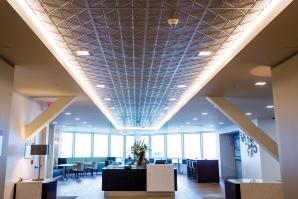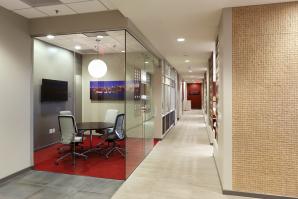The Sacramento economy continues to rebound from some lean years, with job creation in the second quarter of 2014 outpacing the state average. As a result, the market for office space is getting tighter and more competitive. Vacancy rates are declining, especially for premier space, as tenants take advantage of a soft market and move into bigger or nicer digs at bargain prices.
But lessees in today’s marketplace will find tenant improvement allowances 25 to 30 percent less than they were four years ago, a sign that this may no longer be as strong a buyers’ market as it was. Still, rents and improvement allowances are just starting points for a deal, and lessees still have bargaining chips. There are many other factors that can make a deal work for both sides. Here are some tips that might sweeten the deal or — if overlooked — can make one go sour.
If You’re Seeking Tenants…
Talk tech. High-tech offerings lead to high-quality tenants. In a hyper-connected marketplace, outfitting a space to accommodate all the latest high-tech tools is a vital selling point. It doesn’t matter if the property is a skyscraper or a strip mall; fiber-optic cable and wi-fi are the basic minimum, and high-speed service from multiple carriers with privacy protection is even better.
Offering LCD screens with inputs for projectors and laptops can be a wise investment for luring the tenant who needs a productive conference room or collaborative space. An upgraded electrical system to power all those elements is a good selling point, too.
We all take computers for granted, and most of us only see the keyboard and monitor on our desk. But what about the IT support structure? Having a dedicated space for servers and routers can be a strong selling point for landing an accounting firm, law office or call center that moves lots of data and needs to keep it secure.
Put safety first. Besides offering security for data, your building should offer security for the people who work there. A lock on the front door just isn’t enough in some settings. Cameras can track lobby or parking lot traffic, and keypads can limit access to elevators. Offering controlled access to individual suites or floors may be the touch that attracts a tenant who wants exclusivity and privacy. Security personnel who can escort workers to their cars after hours can set your building apart from one down the block.
Cut energy costs. Heating, lighting and cooling an office are often the biggest operating expenses next to IT. California’s newest efficiency standards just went into effect this summer, and they’re hefty but there are ways to help tenants cut energy costs even further or better control their energy use.
In many buildings, tenants pay a pro-rata share for power that goes through a single meter. Offer individual meters for each office space or suite to give tenants more control over their energy budget.
Installing halogen or efficient, fluorescent lighting can cut energy costs, too, as can motion sensors that ensure the lights are on only when someone is in the room. Providing more daylight via added windows and skylights can not only save energy but can make an office more appealing, too.
Open up the space. The corner office may have been in style during the Mad Men era, but they aren’t always a good fit for today’s business culture. If the space you’re offering looks fit for Don Draper, consider opening it up a bit. That’s especially true of the single-person offices from the previous tenant hogged all the window space.
In today’s business world, where employees work in teams and organize themselves around projects, flexibility in space planning is key. Knocking down a wall might open the door to a prospective tenant who might otherwise take a pass on the location.
Clean it up. Experts advise cleaning up the space, too, but there’s no need to overdo it. New carpeting and a fresh coat of paint in a neutral color are usually all it takes to add an upgraded feel to a vacant space. It also lets prospective tenants envision how their business will fit into it.
Pay for packing. Most often, a new tenant may simply be moving across town. But what if the tenant you want is locked into a lease? Consider buying out the remaining time on the existing lease and rolling it into the cost of the new one. It may be a small price to pay to get the tenant you want or for them to get into a space that better suits their needs. Offering a moving allowance or a rebate on the first few months of rent is one way to get the new tenant to pack up and move faster.
If You’re Searching for Space…
Crunch the numbers. Experts say adequate IT space is one of the most overlooked elements in an office, and it can wreak havoc on budgets and floorplans. At a cost of six figures for some systems, a spacious, temperature-controlled IT room can easily blow a budget or an improvement allowance, so shop wisely.
Plan accordingly. If you’re selling spas or ski equipment, your revenue may fluctuate from season to season, with boom times followed by scarcity. Offering lease payments that follow sales trends can give you more pocketbook flexibility. As long as it pencils out for the year, paying more in flush seasons and less in off-seasons can preserve your cash flow and make it easier to manage your finances.
Consider alternative options. If your company is in its embryonic stage and the lease payments on the space you want are just too rich for your pocketbook, consider offering up equity in your company to your prospective landlord. It may be more feasible in industries that spawn many start-ups, such as high-tech, than it is for more traditional companies. But if you are confident your company may be the next Microsoft, stock options can preserve short-term cash flow and offer a potential long-term payoff that may be even greater for the building owner than short-term leasing revenue.
Make a deal. Real estate transactions, even leasing agreements, are not as simple as they seem. Inevitably, there are time-consuming details to work out, from permit fees to space planning. Experts representing building owners and tenants advise working with space planners and architects early to keep the process on schedule.
Think fast. Time is money, of course. But allowing the planning of a new space to bump up against the expiration date of a lease on the old space only invites costly mistakes and oversights. Allowing ample time is the best way to ensure tenant improvement dollars are spent efficiently and that the landlord and the new tenant will settle into a mutually satisfying relationship.
In landing a space for yourself or your tenant, you may not get everything you ask for. But if you get an idea, it never hurts to ask.
Sick of missing out? Sign up for our weekly newsletter highlighting our most popular content. Or take it a step further and become a print subscriber — it’s both glossy and affordable!
Recommended For You

Light Accordingly
Cost-effective lighting is good for owners and tenants
Depending on the type of business you operate, lighting can account for 20 to 50 percent of electricity consumption. This means significant cost savings can be achieved with energy-efficiency upgrades, and due to continually improving equipment, lighting usually provides the highest return on investment of major updates.

Wide-Open Spaces
Banish the cubicles and fake ferns—Creative workers want customizable, collaborative workspaces
The old-school office style emphasized privacy and individual productivity. But the new model prioritizes the ideals of the creative class — that fast-growing, highly educated, well-paid segment of the workforce that values creativity, collaboration and the ability to customize.

Farewell to the Corner Office
The next generation of workpace design
Walk into any coffee shop and it’s obvious that the place we call “the office” has changed. Many of the people sitting at tables are likely mixing laptops with lattes as they browse email and write reports. Some may be pitching a sale over coffee.

Rent the American Dream
Sacramento millennials aren't interested in mortgages
Brian Collins is a 26-year-old director of accounts at Sacramento-based mobile applications marketing firm Appency. He makes what he calls “decent money,” is putting lots of it into a 401(k) and has an eye on his financial future. And, like most people his age, he’s decided that buying a house is not part of the plan.



